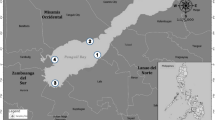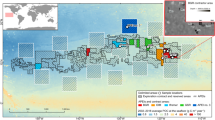Abstract
Analysis of sediments in and around the large and deep burrows made by the callianassid shrimp Callichirus laurae, Jordan Gulf of Aqaba (Red Sea), showed that organic carbon (OC), humic matter (HM), humic (HA) and fulvic acids (FA) are redistributed both quantitatively and qualitatively by sediment reworking activities:
-
1.
OC and humic matter (HM) concentrations are ca. 30 times higher in the stomach content than in surface sand, proving a selective food uptake.
-
2.
a 11 to 17 times increase in OC and HM is observed in the mucus-rich burrow wall when compared to ambient sediment.
Among humic substances, FA seem preferentially absorbed by the shrimp, while HA are concentrated in the fecal pellets.
The spatial distribution of organic matter in the form of a 3D network is discussed in relation with sampling procedures. Due to inadequate sampling gears, organic rich networks such as those of thalassinid shrimps are rarely considered in conventional sampling strategies, leading to an underestimation of the sediment organic content.
Similar content being viewed by others
References
Abu-Hilal, A., M. Badran & J. de Vaugelas, 1988. Redistribution of trace elements in Callichirus laurae burrows (Crustacea: Thalassinidea), Jordan Gulf of Aqaba (Red Sea). Mar. envir. Res. 25: 233–248.
Aller, R. C. & J. Y. Yingst, 1978. Biogeochemistry of tube-dwellings: a study of the sedentary polychaete Amphitrite ornata (Leidy). J. mar. Res. 36: 201–254.
Aller, R. C., J. Y. Yingst & W. J. Ullman, 1983. Comparative biogeochemistry of water in intertidal Onuphis (polychaeta) and Upogebia (crustacea) burrows: temporal patterns and causes. J. mar. Res. 41: 571–604.
Alongi, D. M., 1989. The role of soft-bottom benthic communities in tropical mangrove and coral reef ecosystems. Reviews in Aquatic Sciences, 1: 243–280.
Branch, G. M. & A. Pringle, 1987. The impact of the sand prawn Callianassa kraussi Stebbing on sediment turnover and on bacteria, meiofauna, and benthic microflora. J. exp. mar. Biol. Ecol. 107: 219–235.
Curran, H. A., 1984. Ichnology of pleistocene carbonates on San Salvador, Bahamas. J. Paleontol. 58: 312–321.
Dall, W. & D. J. W. Moriarty, 1983. Functional aspects of nutrition and digestion. In L. H. Mantel (ed.), The Biology of Crustacea. Vol. 5: Internal anatomy and physiological regulation. Academic Press, New York: 215–261.
Debyser, Y. & F. Gadel, 1983. Géochimie des kérogènes. In CNRS (ed.), Géochimie organique des sédiments marins d'ORGON à MISEDOR. Editions du CNRS, Paris: 421–450.
Dobbs, F. C. & J. B. Guckert, 1988. Callianassa trilobata (Crustacea: Thalassinidea) influences abundance of meiofauna and biomass, composition, and physiologic state of microbial communities within its burrows. Mar. Ecol. Prog. Ser. 45: 69–79.
Dworschak, P. C., 1983. The biology of Upogebia pusilla (Petagna) (Decapoda, Thalassinidea). I. The burrows. P.S.Z.N.I.: Marine Ecology 4: 19–43.
Frankenberg, D., S. L. Coles & R. E. Johannes, 1967. The potential trophic significance of Callianassa major fecal pellets. Limnol. Oceanogr. 12: 113–120.
Frankenberg, D. & K. L. Smith Jr., 1967. Coprophagy in marine animals. Limnol. Oceanogr. 12: 443–450.
Gabrié, C. & L. F. Montaggioni, 1982. Sedimentary facies from modern coral reefs, Jordan Gulf of Aqaba, Red Sea. Coral Reefs 1: 115–124.
Hulings, N. C., 1979. The ecology, biometry and biomass of the seagrass Halophila stipulacea along the Jordanian coast of the Gulf of Aqaba. Bot. Mar. 22: 425–430.
Mac Ginitie, G. E., 1934. The natural history of Callianassa californiensis Dana. Am. Midl. Nat. 15: 116–117.
Martin-Buscail, R. T., F. Gadel & J. P. Baruseau, 1981. Holocene evolution of the Canet-St Nazaire lagoon (Golfe du Lion, France) as determined from a study of sediment properties. Sedimentology 28: 823–836.
McMurtry, G. M., R. C. Schneider, P. L. Colin, R. W. Buddemeier & T. H. Suchanek, 1986. Vertical distribution of fallout radionuclides in Enewetak Atoll lagoon sediments: effects of burial and bioturbation on the radionuclide inventory. Bull. mar. Sci. 38: 35–55.
Moore, H. B., 1932. The faecal pellets of the Anomura. Proc. roy. Soc. Edinburgh 52: 296–308.
Nissenbaum, A., 1974. The organic geochemistry of marine and terrestrial humic substances: implications of carbon and hydrogen isotopes studies. In B. Tissot & F. Bienner (eds), Advances in organic geochemistry 1973. Technip, Paris: 39–52.
Ott J. A., B. Fuchs, R. Fuchs & A. Malasek, 1976. Observations on the biology of Callianassa stebbingi Borrodaille and Upogebia litoralis Risso and their effect upon the sediment. Senckenbergiana marit 8: 61–79.
Pemberton, G. S., M. J. Risk & D. E. Buckley, 1976. Supershrimp: deep bioturbation in the Strait of Canso, Nova Scotia. Science 192: 790–791.
Rashid, M. A., 1985. Geochemistry of marine humic compounds. Springer-Verlag, Berlin, 291 pp.
Reiss, Z. & L. Hottinger, 1984. The Gulf of Aqaba. Ecological micropaleontology. Springer-Verlag, Berlin, 354 pp.
Risk, M. J., R. D. Venter, S. G. Pemberton & D. E. Buckley, 1978. Computer simulation and sedimentological implications of burrowing by Axius serratus. Can. J. Earth Sci. 15: 1370–1374.
Romero-Wetzel, M. B., 1989. Branched burrow-systems of the enteropneust Stereobalanus canadensis (Spengel) in deep-sea sediments of the Vöring-Plateau, Norwegian Sea. Sarsia 74: 85–89.
Shinn, E. A., 1968. Burrowing in recent lime sediments of Florida and the Bahamas. J. Paleontol. 42: 879–894.
Strickland, J. D. H. & T. R. Parsons, 1972. A practical handbook of seawater analysis. Bull. Fish. Res. Bd Can. 167: 311 pp.
Suchanek, T. H., 1983. Control of seagrass communities and sediment distribution by Callianassa (Crustacea, Thalassinidea) bioturbation. J. mar. Res. 41: 281–298.
Suchanek, T. H., P. L. Colin, G. M. McMurtry & C. S. Suchanek, 1986. Bioturbation and redistribution of sediment radionuclides in Enewetak Atoll lagoon by callianassid shrimp: biological aspects. Bull. mar. Sci. 387: 144–154.
Thompson, R. K., 1972. Functional morphology of the hindgut gland of Upogebia pugettensis (Crustacea, Thalassinidea) and its role in burrow construction. PhD, University of California, Berkeley, 202 pp.
Tudhope, A. W. & T. P. Scoffin, 1984. The effects of Callianassa bioturbation on the preservation of carbonate grains in Davies Reef lagoon. Great Barrier Reef, Australia. J. sedim. Petrol. 54: 1091–1096.
Vaugelas, J. de, 1984. Preliminary observations on two types of callianassid (Crustacea, Thalassinidea) burrows, Gulf of Aqaba, Red Sea. Proc. Symp. Coral Reef Environ. Red Sea, Jeddah, Jan. 1984: 520–539.
Vaugelas, J. de, 1985. A new technique for collecting large-sized callianassid mud-shrimp (Crustacea, Decapoda, Thalassinidea). Crustaceana 49: 105–109.
Vaugelas, J. de & O. Naïm, 1982. Organic matter distribution in marine sediments of the Jordanian Gulf of Aqaba. Proc. 4th Int. Coral Reef Symp., Manila 1981 1: 405–410.
Vaugelas, J. de & M. de Saint Laurent, 1984. Premières données sur l'écologie de Callichirus laurae (de Saint Laurent), sp. nov., (Crustacea, Thalassinidea): son action bioturbatrice sur les formations sédimentaires du Golfe d'Aqaba (Mer Rouge). C.r. Acad. Sci., Paris t. 298, ser III, 6: 147–152.
Waslenchuk, D. G., E. A. Matson, R. N. Zajac, F. C. Dobbs & J. M Tramontano, 1983. Geochemistry of burrow waters vented by a bioturbating shrimp in Bermudian sediments. Mar. Biol. 72: 219–225.
Weimer, R. J. & J. H. Hoyt, 1964. Burrows of Callianassa major Say, geologic indicators of littoral and shallow neritic environments. J. Paleontol. 38: 761–767.
Whitehead, N., J. de Vaugelas, P. Parsi & M. C. Navarro, 1988. Preliminary study of Uranium and Thorium redistribution in Callichirus laurae (Crustacea: Thalassinidea) burrows and adjacent sediments, Jordan Gulf of Aqaba (Red Sea). Oceanol. Acta 11: 259–266.
Author information
Authors and Affiliations
Additional information
Mission Océanographique Française au Moyen-Orient;
Rights and permissions
About this article
Cite this article
de Vaugelas, J., Buscail, R. Organic matter distribution in burrows of the thalassinid crustacean Callichirus laurae, Gulf of Aqaba (Red Sea). Hydrobiologia 207, 269–277 (1990). https://doi.org/10.1007/BF00041465
Received:
Revised:
Accepted:
Issue Date:
DOI: https://doi.org/10.1007/BF00041465




